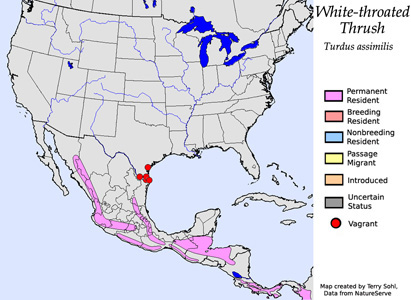| Length: 9 inches | Wingspan: 15 inches | Seasonality: Non-resident in South Dakota |
| ID Keys: Grayish-brown upperparts, paler grayish-brown breast and flanks, white throat with black streaks, white crescent bordering lower throat, yellow eyering | ||
 The
White-throated Thrush is a medium-sized songbird found in Mexico, Central
America, and southward into Ecuador and Columbia. In the United States
they are a rare vagrants, with several sightings in far southern Texas.
The first sighting was a single bird in 1990, with another in 1998.
Additional sightings have been made in recent years. All birds that
have been seen in the U.S. occurred during the winter months. It is
thought that cold weather in their mountainous habitats of northern Mexico
sometimes drive them to lower elevations, including the lowlands of far
southern Texas. No summer records have occurred, and they are very unlikely
to actually breed in the Untied States. They were once known as
"White-throated Robin", a name that confused the species with another
similar-named species from Europe.
The
White-throated Thrush is a medium-sized songbird found in Mexico, Central
America, and southward into Ecuador and Columbia. In the United States
they are a rare vagrants, with several sightings in far southern Texas.
The first sighting was a single bird in 1990, with another in 1998.
Additional sightings have been made in recent years. All birds that
have been seen in the U.S. occurred during the winter months. It is
thought that cold weather in their mountainous habitats of northern Mexico
sometimes drive them to lower elevations, including the lowlands of far
southern Texas. No summer records have occurred, and they are very unlikely
to actually breed in the Untied States. They were once known as
"White-throated Robin", a name that confused the species with another
similar-named species from Europe.
Habitat: Can be found in a variety of forested habitats in its native range, including tropical and subtropical dry or moist forests. They are often found in montane forest areas.
Diet: Feeds on insects and other small invertebrates, fruits and berries.
Behavior: White-throated Thrush may forage anywhere from ground level to high in the forest canopy, depending upon what food source they are after. Foraging for insects and other invertebrates often occurs on or near the ground, although they may also glean insects from vegetation up in the forest canopy.
Nesting: The nest is a cup built of grasses, moss, rootlets, and other vegetative material, bound together with mud and lined with finer material. The female lays between 2 and 4 eggs, and she alone incubates them. The eggs hatch after about 2 weeks, and both parents help to raise and feed the young. The young fledge about 2 weeks after hatching.
Song: The song is described as being similar to an American Robin.
Migration: In their native range they are considered permanent residents. However, colder weather in winter may drive some birds in montane habitats down to lower elevations.
Feeders: They will occasionally attend feeders for offered fruits or nut meal.
Interactive eBird map: Click here to access an interactive eBird map of White-throated Thrush sightings
Similar Species: The combination of the bold yellow eye-ring and obvious throat pattern make the White-throated Thrush distinctive if seen well. Clay-colored Thrush, another rare visitor to the United States, is the species it's perhaps most likely to be confused with.
Conservation Status: Overall populations do appear to be in decline. However, they are still common in parts of their range, and they are found over a broad geographic area. The IUCN currently lists the White-throated Thrush as a species of "Least Concern".
Further Information: 1) Audubon Guide - White-throated Thrush
2) BirdLife International - White-throated Thrush
3) Whatbird - White-throated Thrush
Photo Information: Photo by Amado Demesa - March 22nd, 2014 - Tepoztlan, Morelos, Mexico - Photo licensed under Creative Commons Attribution ShareAlike 2.0 Generic license.
| Click below for a higher-resolution map |
 |
| South Dakota Status: Non-resident in South Dakota |
Additional White-thraoted Thrush Photos (coming soon!!)
